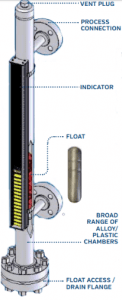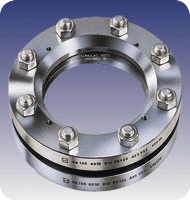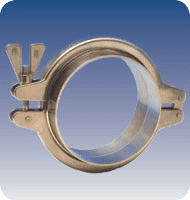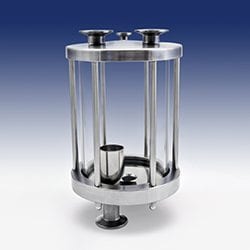How Does a Magnetic Level Gauge Work?
Posted on March 10, 2020 by LJ Star Magnetic level gauges use magnetism to link the indicator in a gauge to a float inside of a vessel in order to accurately show the level of fluid within. As the position of the float changes, the indicator moves up or down by the same amount, meaning that the level in the measuring chamber will always be the same as the fluid level in the vessel itself.
Magnetic level gauges use magnetism to link the indicator in a gauge to a float inside of a vessel in order to accurately show the level of fluid within. As the position of the float changes, the indicator moves up or down by the same amount, meaning that the level in the measuring chamber will always be the same as the fluid level in the vessel itself.
Operating on the principle of conductivity, magnetic level gauges consist of 3 main components: the chamber, the float, and the indicator. The chamber is the main component and can be constructed of any non-magnetic material. It is typically mounted to the side of the vessel, with the liquid level in the chamber set up to match the liquid level in the vessel. While similar to a traditional sight glass in this way, magnetic level gauges can handle some of the more extreme applications, such as ones with highly corrosive or hazardous materials.
To actually get a reading, the ancillary chamber of the magnetic level gauge uses a float that contains a set of permanent magnets. This float is normally constructed of 316 stainless steel or titanium but can be produced using other materials where needed. When the fluid fluctuates in the primary chamber, it results in a proportionate change in the magnetic level gauge. At LJ Star, each float is custom engineered to meet our customer’s specific application. The float is designed to project a magnetic field through the gauge’s chamber to an externally mounted indicator system in order to easily view internal fluid levels. The external indicator is normally comprised of rotating flags that are brightly colored in order to easily identify when the flag is flipped. Each flag is assembled around rare earth magnetic assemblies that ensure a latching action to eliminate false indication due to vibration.
By using a combination of proven buoyancy principles along with the reliability of magnetism, magnetic level gauges offer you peace of mind knowing that your readings are right. At LJ Star, we know just how important that is. Your critical systems need to be accompanied by quality auxiliary equipment.
With their highly accurate fluid measurement capacities, magnetic level gauges are perfect for applications where you want to measure the fluid level in boilers, tanks, and process vessels. Beyond these applications, you can customize a magnetic level gauge to fit virtually any process connection arrangement that you desire.
How Are Magnetic Level Gauges Designed?
Magnetic level gauges are typically made from stainless steel, making their design very durable and resistant to corrosion. This material selection allows these gauges to succeed in difficult applications where other styles of indication may fail.
These robust gauges can hold up to the toughest conditions, including:
- System shock
- Highly corrosive environments
- Hazardous materials
- Vibrations
- High temperatures and pressures
- Excessive moisture
Since these devices mainly operate around magnetism, your measurements won’t be affected if you lose power in your facility. That’s a key feature since those are some of the most important times to keep track of fluid levels.
By using a magnetized shuttle that moves in conjunction with your float’s magnets, you also eliminate the need for restrictive mechanical guide rails. Instead, you can simply rely on your float’s limited lateral motion within the column of the magnetic level gauge. This makes it suitable for fluid mixtures of varying densities. You can also work with a wide variety of fluids, such as:
- Acids
- Butane
- Oils
- Water
For most applications, magnetic level gauges often require little maintenance. No need to constantly recalibrate your equipment – these devices provide repeatable, reliable, and precise level information for you to continuously monitor and record fluid levels.
What to Look For in a Magnetic Level Gauge
It’s always important to specify a proper magnetic level gauge that’s suitable for the operating conditions of your specific process. This will be heavily influenced by:
- Vessel type
- Temperature
- Fluid density
- Working pressure
Aggressive fluid can be addressed by adjusting the construction of both the chamber and the float to higher-grade materials such as Hastelloy or Alloy 20.
Get the Best Magnetic Level Gauge Today
Here at LJ Star, we know that process engineers need the best. That’s why we offer an advanced, non-intrusive magnetic level gauge that provides accurate level readings while protecting operators from high pressure and/or high-temperature fluids.
To make it easy to read from a distance, our magnetic level gauges use a two-color indicator mounted on the gauge chamber but completely isolated from the process fluid. Since the indicator magnetically locks onto the position of the float inside the sealed gauge chamber, moving with the float, you get an accurate real-time indication of the liquid level inside the tank every time you look. We magnetically stabilized the indicator to further ensure accurate level readings regardless of any system of fluid movement.
Click here to take a look at our magnetic level gauges today.
Subscribe to our Blog
Categories
- Certifications
- Company
- In The News
- Industry Information
- METAGLAS® Sight Glasses
- PackExpo 2020
- Sanitary Clamps
- Sanitary Fittings
- Sight Flow Indicator Benefits
- Sight Glass Applications
- Sight Glass Construction
- Sight Glass Lighting
- Sight Glass Lights
- Sight Glass Process Vessel Camera
- Sight Glasses
- Trade Shows
- Webcast


